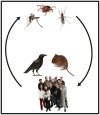Fever versus fever: the role of host and vector susceptibility and interspecific competition in shaping the current and future distributions of the sylvatic cycles of dengue virus and yellow fever virus
- PMID: 23523817
- PMCID: PMC3749261
- DOI: 10.1016/j.meegid.2013.03.008
Fever versus fever: the role of host and vector susceptibility and interspecific competition in shaping the current and future distributions of the sylvatic cycles of dengue virus and yellow fever virus
Abstract
Two different species of flaviviruses, dengue virus (DENV) and yellow fever virus (YFV), that originated in sylvatic cycles maintained in non-human primates and forest-dwelling mosquitoes have emerged repeatedly into sustained human-to-human transmission by Aedes aegypti mosquitoes. Sylvatic cycles of both viruses remain active, and where the two viruses overlap in West Africa they utilize similar suites of monkeys and Aedes mosquitoes. These extensive similarities render the differences in the biogeography and epidemiology of the two viruses all the more striking. First, the sylvatic cycle of YFV originated in Africa and was introduced into the New World, probably as a result of the slave trade, but is absent in Asia; in contrast, sylvatic DENV likely originated in Asia and has spread to Africa but not to the New World. Second, while sylvatic YFV can emerge into extensive urban outbreaks in humans, these invariably die out, whereas four different types of DENV have established human transmission cycles that are ecologically and evolutionarily distinct from their sylvatic ancestors. Finally, transmission of YFV among humans has been documented only in Africa and the Americas, whereas DENV is transmitted among humans across most of the range of competent Aedes vectors, which in the last decade has included every continent save Antarctica. This review summarizes current understanding of sylvatic transmission cycles of YFV and DENV, considers possible explanations for their disjunct distributions, and speculates on the potential consequences of future establishment of a sylvatic cycle of DENV in the Americas.
Keywords: Aedes aegypti; Arbovirus; Dengue virus; Emerging infectious disease; Sylvatic; Yellow fever virus.
Copyright © 2013 Elsevier B.V. All rights reserved.
Figures






References
-
- Amaku M, Coutinho FA, Massad E. Why dengue and yellow fever coexist in some areas of the world and not in others? Bio Systems. 2011;106:111–120. - PubMed
-
- Anez G, Balza R, Valero N, Larreal Y. Economic impact of dengue and dengue hemorrhagic fever in the State of Zulia, Venezuela, 1997–2003. Rev Panam Salud Publica. 2006;19:314–320. - PubMed
-
- . Arbovirus Research Project. University of Ibadan; Ibadan, Nigeria: 1968. Identification of human strains isolated in 1964, 1966, 1967 and 1968, as presumptive dengue virus; pp. 122–123.
-
- . 1969 Annual Report. University of Ibadan Arbovirus Research Project; Ibadan, Nigeria: 1969. Group B arboviruses; pp. 152–162.
Publication types
MeSH terms
Grants and funding
LinkOut - more resources
Full Text Sources
Other Literature Sources
Medical

